Drumsticks
How to choose which Drumsticks to use
- What wood to choose – Maple, Hickory or Oak
- What tip to choose – Nylon or wood
- Choosing the right shape tip – Oval, Mushroom, Fat, or Ball
- What thickness to choose – 7a, 5a, or 2b/5b
- Different Funky Drum Sticks
- Drum Brushes – Dowels and Rutes – Percussion Mallet
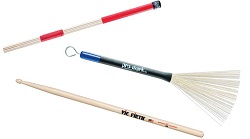 Drumsticks come in all kinds of different sizes and shapes and depending on the type of music you are playing will influence your decision on what type of drumsticks you select to use.
Drumsticks come in all kinds of different sizes and shapes and depending on the type of music you are playing will influence your decision on what type of drumsticks you select to use.
To a drummer, they are as equally important as the other and more expensive parts of the drum equipment and there are many factors that determine the kind of drumsticks you should buy.
If you’re just starting out the most important thing to consider for traditional drumsticks are diameter, length, weight, taper, tip, and type of wood.
The basic drumsticks are long and have a thin design. The wood used in making these sticks is mostly Maple, Oak, or Hickory.
Although initially made from wood, now the sticks available in the market are also made from rubber, plastic, carbon, and nylon.
The thickness of the stick may vary and you can select the right thickness depending on what you wish to play. A drum stick that is not as thick such as 7a is mostly used to play classical, blues, or jazz music. To play hard rock music, you will need a drum stick that has more thickness such as 2b or 5b.
Drumstick Wood
There are 3 main types of wood used to make drumsticks
- Maple is a lighter-weight wood that has excellent flexibility. Maple is great for energy absorption, meaning you will feel less of the hit in your hands.
- Hickory is the most common wood with decent energy absorption and flex.
- Oak is the densest of wood. Oak sticks will not break as much, but you will feel the vibrations a lot more due to poor energy absorption.
Laminated Birch is made from high-quality birch plywood. These sticks are very heavy and durable. They generate very deep sounds from drums and cymbals.
There are smaller companies specializing in exotic woods and currently making carbon fibre sticks. Also, companies like Ahead make sticks out of nylon.
Weight, density, texture, resonance, flexibility, and durability vary from one type of wood to another. For example, oak sticks are exceptionally durable and allow drummers to play louder, with less effort. Maple sticks are lighter and more flexible, but less durable than oak. Hickory drumsticks are resilient, responsive, sturdy, and good shock absorbers, making them the most popular choice.
If the stick doesn’t state what wood it is, this usually means it is a blended wood and is not made up to standard. I would stay away from this type of drumstick.
Choose a Tip
There are 2 types of tips to choose from; Wood and Nylon
Wood is the most common. This is a solid choice for most applications. The only real downside to wood tips is the fact that they may chip after extensive use.
 Nylon tips are great for bringing out your cymbals and getting better rebound from your stick. They are great for studio work when you want to really make your cymbals shine. The problem with nylon tips is they sometimes fall off your stick, which can be a real problem in the middle of a show.
Nylon tips are great for bringing out your cymbals and getting better rebound from your stick. They are great for studio work when you want to really make your cymbals shine. The problem with nylon tips is they sometimes fall off your stick, which can be a real problem in the middle of a show.
Note: If you are playing on an electric drum set, you want to use nylon tips. Wood tips can splinter and severely damage your drum pads!
Choosing the right shape tip
Tips come in many different shapes and sizes each possessing its own feel, and sound!
There are four different tips you may find on most sticks
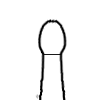 Oval Drum Stick Tip
Oval Drum Stick Tip
- A well-rounded tip, used for most styles
- Produces a warmer tone, with great bounce
- Has a softer tone, and a lighter feel
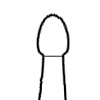 Mushroom Drum Stick Tip
Mushroom Drum Stick Tip
- One the most common tips for rock drumming
- Produces a louder, full sound, with a decent response
- Fairly durable, and well balanced
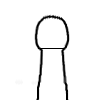 Fat Drum Stick Tip
Fat Drum Stick Tip
- A very durable tip, used for louder, or corps drumming
- Produces a loud full sound, slightly heavier tip
- Great for cymbal crashing, hard on drum skins
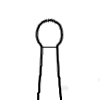 Ball Drum Stick Tip
Ball Drum Stick Tip
- Common with jazz drumming, or snare drumming
- Produces a crisp, bright sound
- Great for Cymbals
I have only talked about four tip shapes but there is a huge range of tip shapes, each producing unique sounds and complimenting specific styles. A perfectly rounded small tip will create a bright, clear tone, while an arrowhead will produce a light, sharp tone.
Choose your Thickness
Once you have an idea of your wood and tip, you need to find the right size stick for you. A difference of only a millimetre or two will affect the feel of a stick in hand. Heavier styles of music often rely on high-diameter heavy-weight sticks whereas softer styles, like blues or jazz, call for slimmer, more articulate sticks. The type of taper will determine how quickly the stick rebounds. A longer taper produces more flex and faster response, while a shorter taper is stiffer and offers additional strength.
Different manufacturers will code their sticks a bit differently, but they are all very similar, and follow a general pattern.
There are three main drumstick thicknesses
7a. this is a thinner, lighter-feeling stick meant for a softer sound on your drums. These work great for jazz drumming, or younger drummers.
5a. this is the most common stick. Medium thickness allows for both loud and softer play. Great for rock drumming!
2b/5b. these are thicker than average. They allow for louder-sounding drums and are ideal for heavy rock.
Stick diameter is fundamental to its feel. Heavier styles of music often rely on high-diameter heavy-weight sticks whereas softer styles, like jazz, call for slimmer, more articulate sticks. Stick length affects leverage and reach.
The type of taper will determine how quickly the stick rebounds. A longer taper produces more flex and faster response, while a shorter taper is stiffer and offers additional strength. The amount of taper and location of the shoulder help to determine the balance of the stick.
The best drumsticks for any player will be straight, sculpted, and well-lathed. Rolling them on a table or across the floor is a great way to test evenness and roundness. Look for sticks that roll in an even, straight line. Finally, be sure that both sticks in a pair have the same sound and feel.
Drum Stick Finish
 Hold the stick as you would while playing and let it slide through your fingers. Different manufacturers use different coatings that affect grip.
Hold the stick as you would while playing and let it slide through your fingers. Different manufacturers use different coatings that affect grip.
What kind of feel is best for you? You may need a stick that will easily slide to alter your grip, without slipping out of your hand. You’ll need to check it out for yourself but it’s definitely something to bear in mind when choosing drumsticks.
Try out the drumsticks, especially if you’re choosing a new kind of drumstick or a brand or size you haven’t used before. Try them gently on a practice pad so that if you choose something else, the store can still sell them, but try them enough to get a feel for their weight, springiness, and balance.
There are specialty sticks with unique designs or added features. Ultimately, your choice will also depend on the type of music you play and the sound you hope to achieve.
Funky Drumsticks
You may have gone into a store and found some different “Funky” looking sticks. These are unique designs made to either increase longevity or grip of your stick.
Rubber sticks are becoming more popular, promising to “never break” and offering replacement sleeves if they do. The problem with these sticks is they are very costly, at around $50 or more a pair. Furthermore; you will find they cut easily on cymbals, and offer weak rim shots on the snare.
Coloured sticks are another design that is growing in popularity. Watch out with these, though, as you will find they tend to mark up your cymbals.
- Always remember; if you are constantly breaking your sticks, check your technique before changing to heavier sticks. With proper technique, sticks should break very seldom. With all this said, you should have no problem selecting the proper stick for yourself. Keep in mind that a drummer’s stick choice is personal, so feel free to experiment around with different sizes and styles.
The Drum Brush
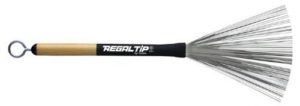 The drum brush is commonly used to play jazz and producing a swooshing, gentle sound on the snare and a light, skittering touch on cymbals. The drum brush has a short handle and a number of bristles that fan out on its top.
The drum brush is commonly used to play jazz and producing a swooshing, gentle sound on the snare and a light, skittering touch on cymbals. The drum brush has a short handle and a number of bristles that fan out on its top.
The brush-style sticks are available in two different types. One is the telescopic drum brush. This drum brush is adjustable and the fan can be made wider or shorter, as required. The other drum brush is non-telescopic. This one has a fan with a fixed length.
The bristles of the fan are made using nylon, metal wire or plastic. The drum brush produces a very light drum beat. It can also be brushed over the drum head surface to produce a constant background sound that can complement other musical instruments.
Once you have done some basic research and understand the difference between the different types of drum brushes, you will be in a better position to buy a drum brush that meets your musical requirements.
Rutes Drum Sticks
 Rutes (a bundle of thin birch dowel or cane) provide a lighter touch and a splashier sound on cymbals. They’re excellent for low-volume practising or for backing up acoustic performances. Sometimes rutes have a movable band to adjust the tightness and produce variations in sound.
Rutes (a bundle of thin birch dowel or cane) provide a lighter touch and a splashier sound on cymbals. They’re excellent for low-volume practising or for backing up acoustic performances. Sometimes rutes have a movable band to adjust the tightness and produce variations in sound.
The Percussion Mallet
 These drumsticks are much more specialized and are used typically by experienced drummers playing in classical concerts or in loud bands. The length of the Percussion Mallet is the same as that of the standard drum stick. However, these sticks have thick handles and their heads are capped using cloth mallets.
These drumsticks are much more specialized and are used typically by experienced drummers playing in classical concerts or in loud bands. The length of the Percussion Mallet is the same as that of the standard drum stick. However, these sticks have thick handles and their heads are capped using cloth mallets.
The percussion mallet drum stick is made mostly using plastic or wood and the mallet on top is usually made with yarn, cotton or any other kind of fabric which is rolled into a ball and attached on top. Even though these sticks are mostly used to play huge kettle drums as well as other loud-sounding or bellowing instruments, they also work quite well with cymbals and can produce a hard-building sound.
